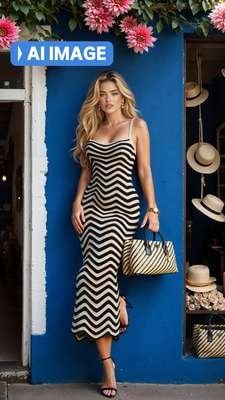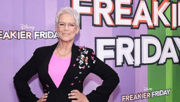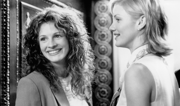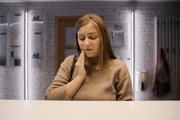Remember when models were real people? Looks like AI has entered the runway
By
Maan
- Replies 0
She had flawless skin, sleek blonde hair and a delicate nose.
She wore the kind of striped maxi dress you'd expect to see on the pages of Vogue—and she was.
But she wasn't real.
For the first time in the magazine's history, Vogue featured an AI-generated model in its August print edition.
The model appeared in a two-page ad for Guess's summer collection, sparking backlash online and reigniting debates around beauty ideals, diversity and the future of fashion itself.
The images were the work of London-based AI marketing agency Seraphinne Vallora, co-founded by former architects Valentina Gonzalez and Andreea Petrescu.
‘When we started, no one was doing this,’ the co-founders shared in a statement.
‘But with the global attention we’ve received and the results we’ve shown, we’re seeing a massive shift in awareness.’
The campaign began when Guess co-founder Paul Marciano reportedly messaged the agency via social media.
Once onboard, Seraphinne Vallora worked with the brand to interpret its creative vision—then spent weeks generating the final images using artificial intelligence.
The process involved hundreds of iterations to fine-tune movement, texture and garment detail.
The result was a spread of summer-ready visuals: one image featured a blonde woman in a floral mini dress, while another showed her in a striped maxi dress posed against a blue wall.
A small disclaimer printed in the top-left corner of the page confirmed the model was AI-generated.
Despite the fine print, readers quickly noticed—and many weren’t impressed.
One person claimed Vogue had ‘lost credibility’, while others said the spread reinforced unattainable beauty standards and questioned whether real models could still compete.
Vogue referred inquiries to Guess, which did not respond before deadline.
According to RMIT fashion lecturer Rashmita Bardalai, AI models offer fashion houses cost savings and more creative freedom than traditional shoots.
‘It also gives them control over styling environments, so they can place models in any type of digital world,’ she said.
But some critics say the creative freedom may come at the cost of inclusivity.
Seraphinne Vallora admitted that audience engagement dropped sharply when they experimented with diverse representations.
‘Our reach would drop from 10 million views per month to just 1 million. That’s a 90 per cent decrease,’ the founders said.
‘We’re simply reflecting what has been established culturally and what audiences still respond to today.’
Dr Bardalai acknowledged that fashion had made ‘real progress’ in embracing different body types, ages, ethnicities, abilities and trans representation in recent years.
She warned that AI must be trained on unbiased datasets to avoid a return to ‘outdated beauty norms’.
Melissa Wilton from the Butterfly Foundation raised concerns about the mental health risks posed by such idealised, artificial imagery.
She referenced a 2024 Dove report showing that nearly 50 per cent of Australian women felt pressured to change their appearance due to online content—even when they knew the images were fake or AI-generated.
‘AI may also reinforce Eurocentric beauty ideals, such as light skin, straight hair and thinness, while also excluding racial minorities,’ she said.
Despite the controversy, Seraphinne Vallora said they anticipated growing demand for AI-generated fashion models.
They clarified they were not trying to replace traditional modelling, but instead offer a lower-cost, faster ‘creative alternative’.
Dr Bardalai noted that while AI could streamline certain industry processes—such as designing for sustainability or minimising return rates—it needed clearer regulation.
She added that AI-generated imagery should be clearly labelled, even though Australian law does not yet require it.
In her view, AI might disrupt elements like lookbooks or teaser campaigns, but it was unlikely to fully replace the real thing.
‘How do we use this as a tool and not as a substitute?’ she asked.
‘But the human touch, the emotional intelligence—of course, that remains irreplaceable.’
If the idea of AI-generated models in Vogue made you pause, you're not alone.
Fashion brands are now blurring the lines between real and digital, sometimes without making it clear to the customer.
One online store was recently caught using completely AI-generated models—and the backlash was swift.
Read more: Wait…are they really using AI models to sell us clothes?

As AI imagery becomes more lifelike and mainstream, will the future of fashion still have room for real faces?
She wore the kind of striped maxi dress you'd expect to see on the pages of Vogue—and she was.
But she wasn't real.
For the first time in the magazine's history, Vogue featured an AI-generated model in its August print edition.
The model appeared in a two-page ad for Guess's summer collection, sparking backlash online and reigniting debates around beauty ideals, diversity and the future of fashion itself.
The images were the work of London-based AI marketing agency Seraphinne Vallora, co-founded by former architects Valentina Gonzalez and Andreea Petrescu.
‘When we started, no one was doing this,’ the co-founders shared in a statement.
‘But with the global attention we’ve received and the results we’ve shown, we’re seeing a massive shift in awareness.’
The campaign began when Guess co-founder Paul Marciano reportedly messaged the agency via social media.
Once onboard, Seraphinne Vallora worked with the brand to interpret its creative vision—then spent weeks generating the final images using artificial intelligence.
The process involved hundreds of iterations to fine-tune movement, texture and garment detail.
The result was a spread of summer-ready visuals: one image featured a blonde woman in a floral mini dress, while another showed her in a striped maxi dress posed against a blue wall.
A small disclaimer printed in the top-left corner of the page confirmed the model was AI-generated.
Despite the fine print, readers quickly noticed—and many weren’t impressed.
One person claimed Vogue had ‘lost credibility’, while others said the spread reinforced unattainable beauty standards and questioned whether real models could still compete.
Vogue referred inquiries to Guess, which did not respond before deadline.
According to RMIT fashion lecturer Rashmita Bardalai, AI models offer fashion houses cost savings and more creative freedom than traditional shoots.
‘It also gives them control over styling environments, so they can place models in any type of digital world,’ she said.
But some critics say the creative freedom may come at the cost of inclusivity.
Seraphinne Vallora admitted that audience engagement dropped sharply when they experimented with diverse representations.
‘Our reach would drop from 10 million views per month to just 1 million. That’s a 90 per cent decrease,’ the founders said.
‘We’re simply reflecting what has been established culturally and what audiences still respond to today.’
Dr Bardalai acknowledged that fashion had made ‘real progress’ in embracing different body types, ages, ethnicities, abilities and trans representation in recent years.
She warned that AI must be trained on unbiased datasets to avoid a return to ‘outdated beauty norms’.
Melissa Wilton from the Butterfly Foundation raised concerns about the mental health risks posed by such idealised, artificial imagery.
She referenced a 2024 Dove report showing that nearly 50 per cent of Australian women felt pressured to change their appearance due to online content—even when they knew the images were fake or AI-generated.
‘AI may also reinforce Eurocentric beauty ideals, such as light skin, straight hair and thinness, while also excluding racial minorities,’ she said.
Despite the controversy, Seraphinne Vallora said they anticipated growing demand for AI-generated fashion models.
They clarified they were not trying to replace traditional modelling, but instead offer a lower-cost, faster ‘creative alternative’.
Dr Bardalai noted that while AI could streamline certain industry processes—such as designing for sustainability or minimising return rates—it needed clearer regulation.
She added that AI-generated imagery should be clearly labelled, even though Australian law does not yet require it.
In her view, AI might disrupt elements like lookbooks or teaser campaigns, but it was unlikely to fully replace the real thing.
‘How do we use this as a tool and not as a substitute?’ she asked.
‘But the human touch, the emotional intelligence—of course, that remains irreplaceable.’
If the idea of AI-generated models in Vogue made you pause, you're not alone.
Fashion brands are now blurring the lines between real and digital, sometimes without making it clear to the customer.
One online store was recently caught using completely AI-generated models—and the backlash was swift.
Read more: Wait…are they really using AI models to sell us clothes?
Key Takeaways
- Vogue featured an AI model for the first time in its August 2025 issue.
- The ad campaign was produced by London-based AI agency Seraphinne Vallora for Guess.
- The move sparked backlash over beauty standards, diversity and job security for real models.
- Experts say clearer regulation and ethical AI training are needed to protect fashion’s progress.
As AI imagery becomes more lifelike and mainstream, will the future of fashion still have room for real faces?








